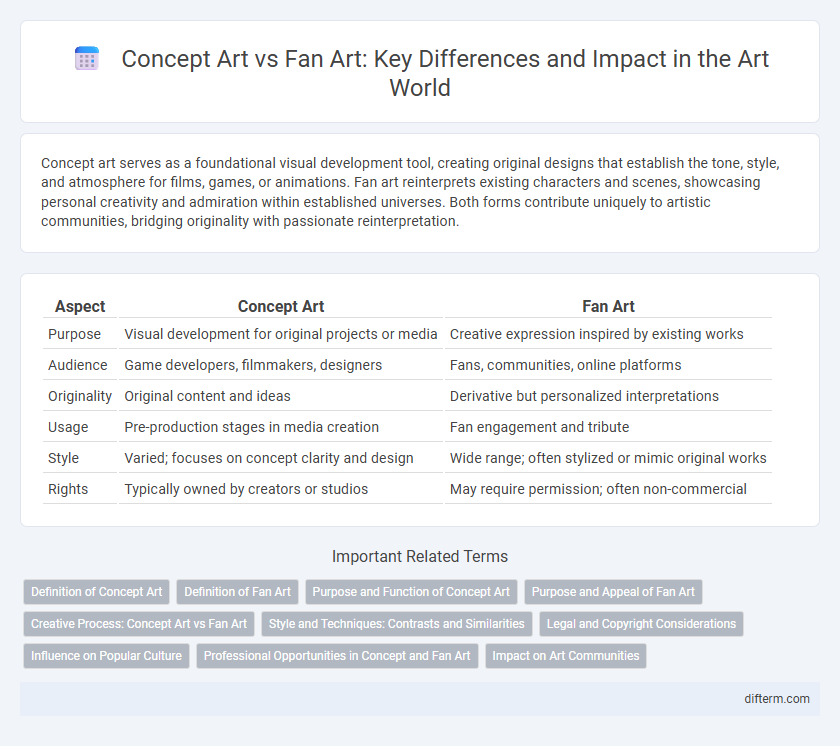Concept art serves as a foundational visual development tool, creating original designs that establish the tone, style, and atmosphere for films, games, or animations. Fan art reinterprets existing characters and scenes, showcasing personal creativity and admiration within established universes. Both forms contribute uniquely to artistic communities, bridging originality with passionate reinterpretation.
Table of Comparison
| Aspect | Concept Art | Fan Art |
|---|---|---|
| Purpose | Visual development for original projects or media | Creative expression inspired by existing works |
| Audience | Game developers, filmmakers, designers | Fans, communities, online platforms |
| Originality | Original content and ideas | Derivative but personalized interpretations |
| Usage | Pre-production stages in media creation | Fan engagement and tribute |
| Style | Varied; focuses on concept clarity and design | Wide range; often stylized or mimic original works |
| Rights | Typically owned by creators or studios | May require permission; often non-commercial |
Definition of Concept Art
Concept art serves as a foundational visual guide used to convey ideas and design elements for characters, environments, and objects in media productions such as video games, films, and animation. It focuses on original creations that establish the aesthetic and mood prior to the final production stages. Unlike fan art, which reimagines existing works, concept art is an essential step in the creative development process to visualize new content.
Definition of Fan Art
Fan art is artwork created by enthusiasts that depicts characters, scenes, or elements from existing media franchises, such as movies, video games, or comics. Unlike concept art, which serves as original design work for developing new creative projects, fan art expresses personal interpretation and admiration of established intellectual properties. This form of art often circulates within fan communities and emphasizes creativity within the boundaries of pre-existing narratives.
Purpose and Function of Concept Art
Concept art serves as a vital blueprint in the creative process, providing visual guidance for the development of characters, environments, and props within films, video games, and animations. It functions to communicate ideas clearly to production teams, ensuring consistency and coherence throughout the project's development. Unlike fan art, which is created primarily for personal expression and tribute, concept art drives innovation and storytelling in professional design workflows.
Purpose and Appeal of Fan Art
Fan art serves as a creative tribute that deepens emotional connections between fans and original works, often reflecting personal interpretation and enthusiasm. It appeals through familiarity and community, enabling artists to explore beloved characters and settings while engaging with a shared culture. Unlike concept art, which focuses on the initial visualization and development of new ideas, fan art thrives on celebrating existing narratives and fostering communal interaction.
Creative Process: Concept Art vs Fan Art
Concept art involves the creation of original designs, characters, and environments, serving as a foundational blueprint for video games, movies, and animations. Fan art, by contrast, reinterprets existing media properties, allowing artists to explore and personalize beloved characters through a unique artistic lens. The creative process in concept art requires extensive research, iteration, and collaboration, while fan art emphasizes individual expression and tribute within established visual frameworks.
Style and Techniques: Contrasts and Similarities
Concept art emphasizes original design and world-building, often using digital painting techniques to create detailed and immersive environments, characters, and props that serve as visual blueprints for media productions. Fan art, while also utilizing digital or traditional mediums, tends to reinterpret existing characters or scenes with varying degrees of stylistic fidelity, often highlighting the artist's personal flair or homage to the source material. Both styles demand strong foundational skills in anatomy, perspective, and color theory, but concept art prioritizes functionality and innovation, whereas fan art focuses on expression and community engagement.
Legal and Copyright Considerations
Concept art serves as original content created to visualize ideas and characters, often protected under copyright as the intellectual property of the artist or commissioning entity. Fan art, while inspired by existing copyrighted works, poses legal risks if distributed or sold without permission, potentially infringing on the original creator's copyright. Understanding the distinctions in copyright law between derivative works and original creations is crucial for artists to navigate intellectual property rights responsibly.
Influence on Popular Culture
Concept art drives innovation in visual storytelling by shaping the original vision of movies, games, and animations, establishing foundational aesthetics that influence mainstream media. Fan art builds community engagement and cultural dialogue by reinterpreting and celebrating beloved characters, contributing to the sustained popularity and evolution of franchises. Together, these art forms fuel a dynamic exchange between creators and audiences, expanding the reach and impact of popular culture.
Professional Opportunities in Concept and Fan Art
Concept art offers expansive professional opportunities in industries such as video games, film, and animation, where originality and visual storytelling are paramount. Fan art, while often limited to personal or community recognition, can lead to freelance commissions and social media monetization, building a personal brand and audience. Mastery in concept art requires skills in character design, environment creation, and narrative visualization, making it a pivotal entry point for careers in entertainment and media production.
Impact on Art Communities
Concept art drives innovation in art communities by shaping original visual narratives and influencing game design, film production, and animation industries. Fan art fosters community engagement and cultural exchange, allowing artists to reinterpret existing intellectual properties and connect with like-minded enthusiasts. Both forms contribute uniquely to artistic diversity, creativity, and collaborative opportunities within digital and traditional art spaces.
concept art vs fan art Infographic

 difterm.com
difterm.com